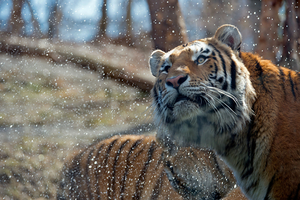Elusive Siberian tigers captured in spectacular photos
A duo of photographers have snapped spectacular photos of Russia's Amur tigers.

Amur tigers enjoy the water, not a common predilection among cats. These tigers swim and splash in bodies of water, sometimes even crossing the wide Amur River that forms the border between the Russian Far East and northeast China.
Julie Larsen Maher ©WCS
Jonathan Slaght is projects manager for WCS's Russia Program. Julie Larsen Maher is staff photographer for the Wildlife Conservation Society (WCS), the first woman to hold the position since the society's founding in 1895. In addition to field visits, Maher photographs the animals at WCS's five New York-based wildlife parks: the Bronx Zoo, Central Park Zoo, New York Aquarium, Prospect Park Zoo and Queens Zoo. The authors contributed this article to Live Science's Expert Voices: Op-Ed & Insights.
Siberian tigers buck the trend.
Most people think of tigers as regal beasts creeping through steamy subtropical jungles against the background cacophony of shrieking monkeys and barking deer. But these cats live in the snow-covered lands of the Russian Far East. They are also known as Amur tigers, as there are no tigers in Siberia; Russian tigers live in the Amur River basin, hence Amur tiger, and they hunt deer and boar in oak forests not too different from those in the northeastern United States. And in autumn, these tigers' orange coats blend with the fall colors to render them almost invisible to prying eyes. [Iconic Cats: All 9 Subspecies of Tigers ]
Their camouflage and stealth aren't the only reasons Amur tigers are hard to see: These cats have territories 20 times larger than those of the tigers living in southeast Asia. A single Amur male might have a territory up to 500 square miles (1,295 square kilometers) in size. This is because there are far fewer prey animals in the harsher climate of Russia than in jungles, so tigers have to go much further to find and kill enough prey to survive. So, given their camouflage and their rarity, Amur tigers are almost impossible to see.
The tigers almost went extinct in the wild. Luckily, the concerted efforts of dedicated scientists and far-sighted Soviet officials in the middle of the last century bore fruit, and today Russia is the only tiger-range state to demonstrate a recovery of tiger populations. Hundreds of the cats roam the forests now, where 70 years ago there were only a few dozen.
These images celebrate Amur tigers and their habitat: May these temperate forests of the Russian Far East forever echo with the haunting roars of these incredible animals.
In New York, Amur tigers call the Wildlife Conservation Society's Bronx Zoo home. They live in Tiger Mountain, where they play a vital role as representatives for their wild relatives.
Fall for Tigers
Tigers of the Temperate Forest
A Coat for All Seasons
A Cat That Likes to Swim
Raspberry Pass
Small Cubs, Big Cats
Chain of Command
Let It Snow
Follow the Footprints
Learn more about Amur tigers and other wildlife on the WCS photo blog, Wild View, in the post Looking for the Last of the Wild, and on Jonathan Slaght's tiger blog.
Follow all of the Expert Voices issues and debates — and become part of the discussion — on Facebook, Twitter and Google+. The views expressed are those of the author and do not necessarily reflect the views of the publisher. This version of the article was originally published on Live Science.
- U.S. 'Pet' Tiger Trade Puts Big Cats at Great Risk (Op-Ed)
- Boas, Chimps or Tigers: Wild Animals Are Not Pets (Op-Ed)
- Will Canine Distemper Wipe Out Rare Tigers?
Copyright 2015 LiveScience, a Purch company. All rights reserved. This material may not be published, broadcast, rewritten or redistributed.

